
Hawk/Scratchbuilt 1/72 Kyushu K10W1 trainer
| KIT #: | ? |
| PRICE: | $ |
| DECALS: | spares bin |
| REVIEWER: | Brian Baker |
| NOTES: | Kitbash/Scratchbuilt |

| HISTORY |
Wartime propaganda gave the American public the impression that virtually all Japanese aircraft used during the war were unoriginal in concept, and plagiaristic in design and construction techniques. Subsequent historical treatment of the K10W1 bears this out. The K10W1 was produced for the Imperial Japanese Navy during World War II, and was roughly in the same class as the Vultee BT-13 and North American BT-9.
DESIGN ORIGINS
In 1937, the Mitsubishi firm obtained
two early models of the North American NA-16 basic trainer, which was similar in
most respects to the U.S. Army’s BT-9 basic trainer. Both were tested by the
IJN as KXA1 and KXA2, Navy Experimental Type A intermediate trainers. T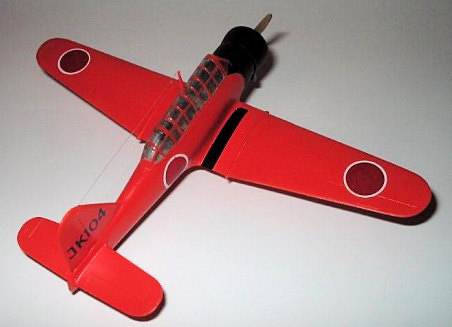 he Navy
subsequently acquired a production license for the aircraft, and this has led
some reputable historians to the conclusion that the production model was
essentially a revised North American NA-16 airframe. It is this author’s opinion
that this is inaccurate, and that, in fact, the Japanese used the basic concept
of the design to produce an entirely original airplane suited to Japanese
requirements and production techniques. It was certainly similar in overall
configuration to the NA-16, but the detail differences were such that it was no
more similar to a BT-9 than a Douglas DC-8 or Convair 880 was similar to the
original Boeing 707.
he Navy
subsequently acquired a production license for the aircraft, and this has led
some reputable historians to the conclusion that the production model was
essentially a revised North American NA-16 airframe. It is this author’s opinion
that this is inaccurate, and that, in fact, the Japanese used the basic concept
of the design to produce an entirely original airplane suited to Japanese
requirements and production techniques. It was certainly similar in overall
configuration to the NA-16, but the detail differences were such that it was no
more similar to a BT-9 than a Douglas DC-8 or Convair 880 was similar to the
original Boeing 707.
THE WATANABE DESIGN
The Watanabe Tekkosho was instructed to design an aircraft similar to the NA-16’s then being tested, and the result was the K10W1, 14 Shi Intermediate Training landplane, Type 2. The K10W1, which was eventually code named ”Oak” by the Allied intelligence community, was a low winged, single engine two seat training monoplane with tandem cockpits and fixed, spatted landing gear. The plane was powered by a Nakajima Kotobuki 2 Kai air cooled radial engine rated at 600 hp, considerably more power than the NA-16 had, and equal to that of the later AT-6. Although the plane was superficially similar to the NA-16, a close examination of photographs and accurate drawings will show that the airplane was actually an entirely new design.
When I started researching this
aircraft, I saw the drawings in Francillon’s JAPANESE AIRCRAFT OF THE PACIFIC
WAR, and thought that I had finally found an accurate drawing from which to base
my model. The three view drawings appeared to be very convincing, but upon
closer examination of the photos, I came to the conclusion that the artist had
merely taken a drawing of a BT-9 and made minor corrections. The photo in
Francillon’s book shows the KXA1, one of the two North American NA-16’s acquired
by the Japanese. They certainly don’t represent the K10W1 in its production
configuration. Years ago, in the mid
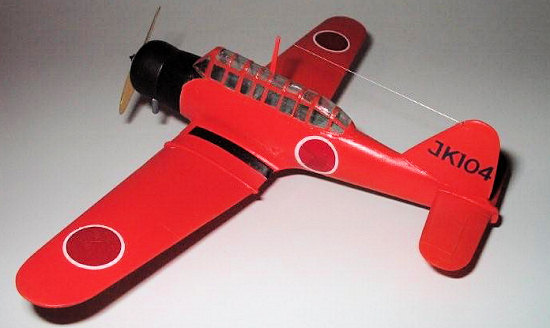 seventies, and the three view depicts a
composite aircraft with some features of the K10W1, although they are inaccurate
in many respects. I actually built a model from a Hawk AT-6 kit, based on Francillon’s drawings, with the article appearing in an early issue of IPMS
Phoenix’s DIRTY PLASTIC.
seventies, and the three view depicts a
composite aircraft with some features of the K10W1, although they are inaccurate
in many respects. I actually built a model from a Hawk AT-6 kit, based on Francillon’s drawings, with the article appearing in an early issue of IPMS
Phoenix’s DIRTY PLASTIC.
Later, in 1985, on the advice of Al Simmons, of Timonium, MD, I became aware of another book, Nozawa’s ENCYCLOPEDIA OF JAPANESE AIRCRAFT, and managed to acquire a more accurate three view of the type. This also contained some photos of the type which also conflicted in minor ways with the Nozawa drawings. For one thing, the wingtips in Nozawa’s drawings show a shape similar to that of an AT-6, while the photos show a rounded circular shape. I have made the corrections on a revised drawing included here. But it was a start. A total of 26 K10W1’s was completed by Watanabe during 1941 and 1942, and a further 150 by Nippon Hikoki K.K. during 1943 and 1944. These numbers, when compared to U.S. output of training aircraft during this period, will illustrate why the Japanese ran out of experienced pilots towards the end of the war. By the way, although the airplane is known as the Kyushu K10W1, it was apparently never manufactured in quantity by that firm, so why it was known by that name is a mystery.
| THE KIT |
Since there was no kit of this
aircraft at the time I did this one (1994), I used the Hawk kit. I
discarded the tail unit, landing gear, cowling, prop, and canopy, using only the
wing and center section. The other parts were made up fro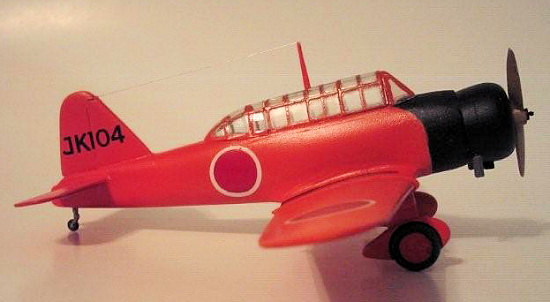 m
card, although the wheels and spats came from a Monogram F11C-2 Goshawk,
the cowling came from something Japanese lurking in the spares box, and the
prop, I believe, came from an Entex World War I kit of some sort. (It’s been a
long time.) The canopy was vacuformed, and the interior was built up from
spare parts.
m
card, although the wheels and spats came from a Monogram F11C-2 Goshawk,
the cowling came from something Japanese lurking in the spares box, and the
prop, I believe, came from an Entex World War I kit of some sort. (It’s been a
long time.) The canopy was vacuformed, and the interior was built up from
spare parts.
Since that date, apparently three kits of this aircraft have appeared in 1/72 scale. I have seen none of these.
A.V. Resin Kit No. 75, selling for 21.50 Euros.
O’Neil Vacuforms
A.V. Models Injection Molded Kit No. 72004 $23.00 USD.
| CONSTRUCTION |
Having several old Hawk AT-6 kits in my stash, I used one for my model. It would have been discarded or traded off anyway, so in essence, the kit was free. So this model was an investment in time only, but quite a lot of that since there were so many changes to make.
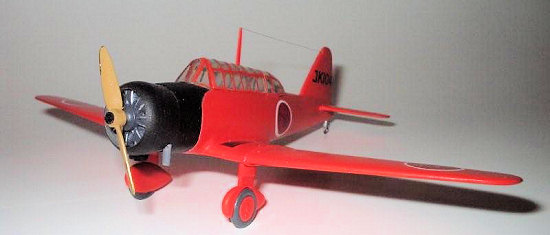 The fuselage was a pretty good place
to start, as it is pretty close to the shape of the K10W1. A certain amount of
filler was required on the underside, since the wing has to be moved back
several feet in scale. The interior needs to be added, although I had no idea
what it looked like, so I improvised. It must have been similar to a BT-9 or
AT-6. After shaping the fuselage, the wing needed a lot of work. The AT-6 wheel
wells had to be removed and smoothed over, and the underside of the forward
section of the fuselage was recontoured to produce an accurate outline. The
outer wing panels needed reshaping, as they tapered both fore and aft, not just
forward like the AT-6, so I trimmed down the trailing edges of the outer wing
panels until they had the required forward taper. I then rescribed the panel
lines lightly, and the results were satisfactory.
The fuselage was a pretty good place
to start, as it is pretty close to the shape of the K10W1. A certain amount of
filler was required on the underside, since the wing has to be moved back
several feet in scale. The interior needs to be added, although I had no idea
what it looked like, so I improvised. It must have been similar to a BT-9 or
AT-6. After shaping the fuselage, the wing needed a lot of work. The AT-6 wheel
wells had to be removed and smoothed over, and the underside of the forward
section of the fuselage was recontoured to produce an accurate outline. The
outer wing panels needed reshaping, as they tapered both fore and aft, not just
forward like the AT-6, so I trimmed down the trailing edges of the outer wing
panels until they had the required forward taper. I then rescribed the panel
lines lightly, and the results were satisfactory.
The tailplanes were built up from card plastic, as they were completely different from the AT-6. The cowling was discovered in my spares box, as was the engine, and I don’t know their original sources. They were suitably detailed and painted before being mounted on the forward fuselage. The landing gear was built up from card and F11C-2 wheel spats, and mounted in the proper position on the undersides of the wings. After the interior was detailed, the canopy was vacuformed, from a mold I made, on my Mattel unit, masked, and mounted over the cockpit. The tailwheel also came from the spares box. Never throwing anything away does have its advantages.
| COLORS & MARKINGS |
There were several paint schemes used by the JNAF during the course of the war, including bright orange overall, and dark green over orange. I opted for the more colorful scheme, with the specified black nose anti-glare and trim. This makes for a colorful model. Letters and hinomarus came from the decal spares box, and I think the result was pretty good, given the information I had available at the time.
| CONCLUSIONS |
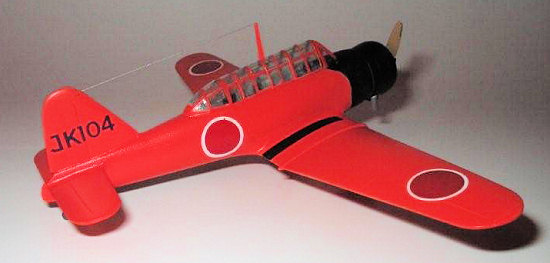 I have not seen any of the available
kits of this aircraft, so I can’t compare my model with any of them. If they
used accurate information, they would probably be impressive, but if they used
obsolete data and drawings, and much of the internet material I dug up in the
last couple of days still showed the old Francillon drawings, then they would
not be accurate. You need to compare the models with the available photos to
check this out. I’ll include my revision of the Nozawa three view for
comparison.
I have not seen any of the available
kits of this aircraft, so I can’t compare my model with any of them. If they
used accurate information, they would probably be impressive, but if they used
obsolete data and drawings, and much of the internet material I dug up in the
last couple of days still showed the old Francillon drawings, then they would
not be accurate. You need to compare the models with the available photos to
check this out. I’ll include my revision of the Nozawa three view for
comparison.
In any event, this was a fun conversion, and I now have a model of a significant but largely unknown aircraft.
January 2008
Copyright ModelingMadness.com. All rights reserved. No reproduction in part or in whole without express permission.
If you would like your product reviewed fairly and fairly quickly, please contact the editor or see other details in the Note to Contributors.